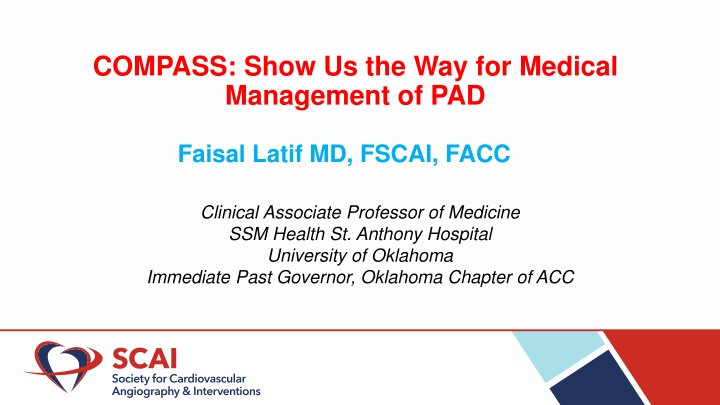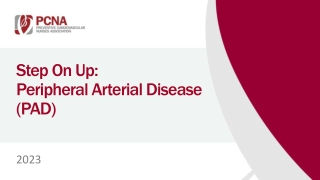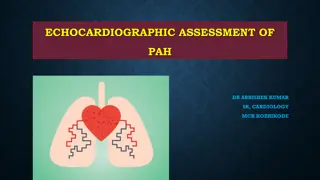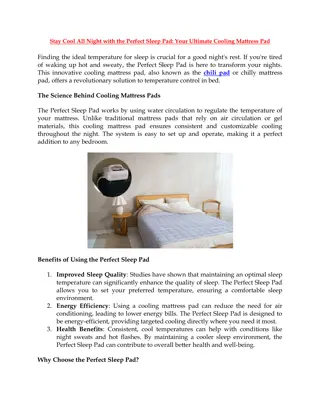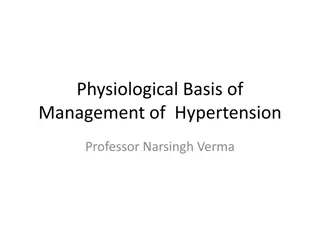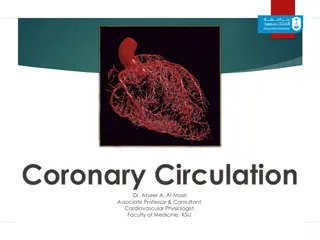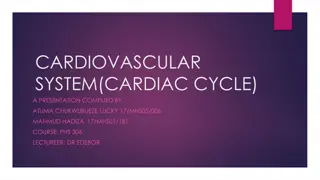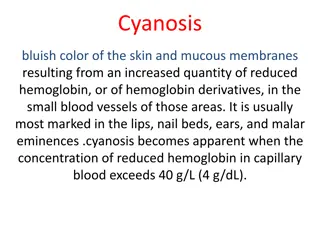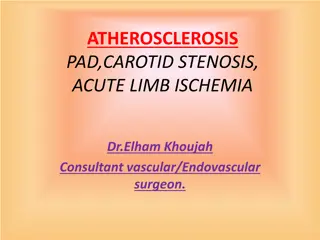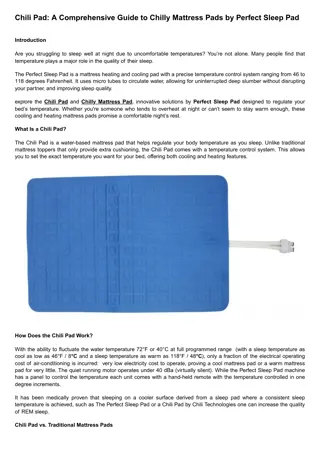Comprehensive Medical Management of Peripheral Arterial Disease (PAD)
Discussing the challenges and gaps in the medical management of PAD, this presentation by Dr. Faisal Latif highlights the unique issues faced by patients with PAD and the limitations of current treatment options. It delves into the current guidelines for symptomatic PAD and explores the findings of the COMPASS trial, shedding light on the trial design, eligible patients, study arms, and primary outcomes. The presentation aims to provide insights into improving the medical management of PAD for better patient outcomes.
Download Presentation

Please find below an Image/Link to download the presentation.
The content on the website is provided AS IS for your information and personal use only. It may not be sold, licensed, or shared on other websites without obtaining consent from the author.If you encounter any issues during the download, it is possible that the publisher has removed the file from their server.
You are allowed to download the files provided on this website for personal or commercial use, subject to the condition that they are used lawfully. All files are the property of their respective owners.
The content on the website is provided AS IS for your information and personal use only. It may not be sold, licensed, or shared on other websites without obtaining consent from the author.
E N D
Presentation Transcript
COMPASS: Show Us the Way for Medical Management of PAD Faisal Latif MD, FSCAI, FACC Clinical Associate Professor of Medicine SSM Health St. Anthony Hospital University of Oklahoma Immediate Past Governor, Oklahoma Chapter of ACC
Disclosures Speaker: Abbott Vascular, Inc
Peripheral arterial disease: Scope & Gaps Peripheral arterial disease: Scope & Gaps 8.5 million Americans have PAD >200 million PAD patients worldwide Medical treatment of PAD has largely been extrapolated from CAD Unique issues in patients with PAD such as disability, amputations No reliable preventive treatment for acute limb ischemia
Peripheral arterial disease: Scope & Gaps Peripheral arterial disease: Scope & Gaps Current guidelines for symptomatic PAD: Class 1: ASA or Clopidogrel Insufficient! Class 2b: DAPT or ASA + Vorapaxar Post-revascularization: DAPT (based on observational data or extrapolation from coronary data) Bonaca, et al. TRA2 P TIMI 50. Circulation 2013; 127: 1522-9
COMPASS COMPASS- -PAD: Trial Design PAD: Trial Design Multi-center, double-blind, RCT at 558 centers in 33 countries (2013-2016) Included 7470 patients encompassing 27% of the patients enrolled in the main COMPASS trial (27,395 patients) Eligible patients: H/O LE-PAD: Previous bypass or PTA, amputation, claudication with objective evidence of PAD Carotid disease (previous revascularization or asymptomatic stenosis > 50%) CAD with ABI < 0.9 3 study arms (1:1:1) Aspirin 100mg once daily + Rivaroxaban (2 5 mg twice daily) Rivaroxaban 5mg twice daily Aspirin 100mg once daily Anand SS, et al. Lancet 2018; 391: 219-29.
Trial Profile Trial Profile Primary outcome: CV death, MI or stroke, Major adverse limb events including major amputation
Primary Outcome Primary Outcome
Primary & Secondary Outcomes Primary & Secondary Outcomes ASA + Riva 2.5mg ASA alone HR (95% CI) P-value CV death/MI/Stroke 126 174 0.72 (0.57-0.9) 0.004 CHD death/MI/ischemic stroke/ALI 115 169 0.68 (0.53-0.86) 0.001 Individual outcomes of MI, Stroke, CV death and Death were not different
Major Adverse Limb Events: Cumulative Major Adverse Limb Events: Cumulative
Limb Outcomes Limb Outcomes ASA + Riva 2.5mg ASA alone HR (95% CI) P-value Acute Limb Ischemia 19 34 0.56 (0.32-0.99) 0.042 Chronic limb ischemia 16 24 0.67 (0.35-1.26) 0.21 Major adverse limb events 30 56 0.54 (0.35-0.84) 0.005 Amputation 5 17 0.30 (0.11-0.8) 0.01 MALE/Amp 32 60 0.54 (0.35-0.82) 0.003
The Bleeding Cost The Bleeding Cost ASA + Riva 2.5mg ASA alone HR (95% CI) P-value Major bleeding 77 48 1.61 (1.12-2.31) 0.0089 Fatal 4 3 - - GI bleed 41 18 2.28 (1.31-3.96) 0.0027 Intracranial 5 9 0.56 (0.19-1.66) - Although major bleeding was increased, fatal or critical organ bleeding was not
Net Clinical Benefit Net Clinical Benefit ASA + Riva 2.5mg ASA alone HR (95% CI) P-value CV death/MI/Stroke/critical organ or fatal bleed 140 185 0.75 (0.60-0.94) 0.011 CV death/MI/Stroke/MALE/major amp/fatal or critical organ bleed 169 234 0.72 (0.59-0.87) 0.0008 MALE = Major adverse limb events
After PAD Revascularization: Endovascular After PAD Revascularization: Endovascular Guidelines LOE Class Recommendation ACC/AHA 2b C DAPT may be reasonable to reduce limb-related events post LE revasc ESC 2A C DAPT for 1 month Chest 1A Doesn t recommend DAPT
What hasnt worked? Post What hasn t worked? Post- -Bypass Bypass Dutch Bypass Oral Anticoagulants N = 2690 CASPAR: DAPT Post-bypass N = 851 Graft Occlusion HR 0.95 (0.82-1.11), p = NS Graft occlusion, revasc, amp, death HR 0.98 (0.78-1.23), p = NS GUSTO Bleeding HR 2.84 (1.32-6.08) Increased risk of hemorrhagic stroke HR 3.48 (1.14-10.60
After PAD Revascularization: VOYAGER After PAD Revascularization: VOYAGER- -PAD ASA + Rivaroxaban 2.5mg BID vs ASA alone PAD Qualifying revascularization (within 10 days): - Endovascular: 65% - Surgical: 35% 2015-2018 Indication: - Claudication: 77% - CLI: 23% Primary outcome: Composite of ALI, major amputation (vascular), MI, ischemic stroke, CV death Bonaca MP, et al. NEJM 2020
Primary & Secondary Outcomes Primary & Secondary Outcomes ASA + Riva ASA alone HR (95% CI) P-value Composite of ALI, major amputation (vascular), MI, ischemic stroke, CV death 508 584 0.85 (0.76-0.96) 0.0085 Acute limb ischemia 155 227 0.67 (0.55-0.82) <0.05 Amputation 103 115 0.89 (0.68-1.16) - Unplanned revasc for recurrent ischemia 584 655 0.88 (0.79-0.99) 0.03
Bleeding Outcomes Bleeding Outcomes ASA + Riva 2.5mg ASA alone HR (95% CI) P-value TIMI major bleeding 62 44 1.43 (0.97-2.10) 0.07 Fatal 6 6 1.02 (0.33-3.15) - Intracranial 13 17 0.78 (0.38-1.61) - ISTH major bleeding 140 100 1.42 (1.10-1.84) 0.007
What about What about Clopidogrel Clopidogrel? ? Subgroup analysis of VOYAGER PAD: n = 6564 Riva 2.5 + ASA + Clopidogrel vs Riva 2.5 + ASA Primary endpoints: First major thrombotic event: MI, ischemic stroke, CV death, ALI, amputation First major TIMI bleed Hiatt WR et al. ACC 20, Abstract 406-13.
What about What about Clopidogrel Clopidogrel? ? Rivaroxaban + aspirin versus aspirin + placebo (no clopidogrel) Addition of clopidogrel to Rivaroxaban + aspirin versus aspirin + placebo @ 3 years P value Major thrombotic vascular events 21.5% vs. 18.7% 16.0% vs. 18.3% P interaction: 0.9163 HR 0.86 HR 0.85 Major TIMI bleeding events 2.6% vs. 1.5% 2.7% vs 2.3% P interaction: 0.69 HR 1.55 HR 1.32 Hiatt WR et al. ACC 20, Abstract 406-13.
How I manage PAD patients How I manage PAD patients Aspirin 81mg ACE-I, Statin, Exercise, Smoking cessation Rivaroxaban 2.5mg BID (when bleeding risk not elevated) Add PPI to (almost) every patient on ASA + Rivaroxaban
When is bleeding risk elevated? When is bleeding risk elevated? Need for long-term DAPT Ischemic stroke within 6 months Any previous hemorrhagic or lacunar stroke Advanced CHF GFR <30 Hgb <11 Platelets <100k Cirrhosis with portal HTN Bleeding requiring transfusion or hospitalization within 6 months OR recurrent bleeding events
Benefit of Benefit of ASA+Riva ASA+Riva 2.5 preserved with GFR <60 2.5 preserved with GFR <60 Sub-analysis of COMPASS trial GFR >60 vs. GFR <60 Fox K, et al JACC 2019
Take Home Points Take Home Points ASA + Rivaroxaban 2.5mg BID ASA + Rivaroxaban 2.5mg BID COMPASS-PAD & VOYAGER-PAD are landmark trials in PAD This combo reduced MACE, limb events, compared with aspirin alone For patients undergoing conservative and revascularization procedures for PAD For both surgical and endovascular PPI might reduce GI bleed events with this combo (results awaited)
